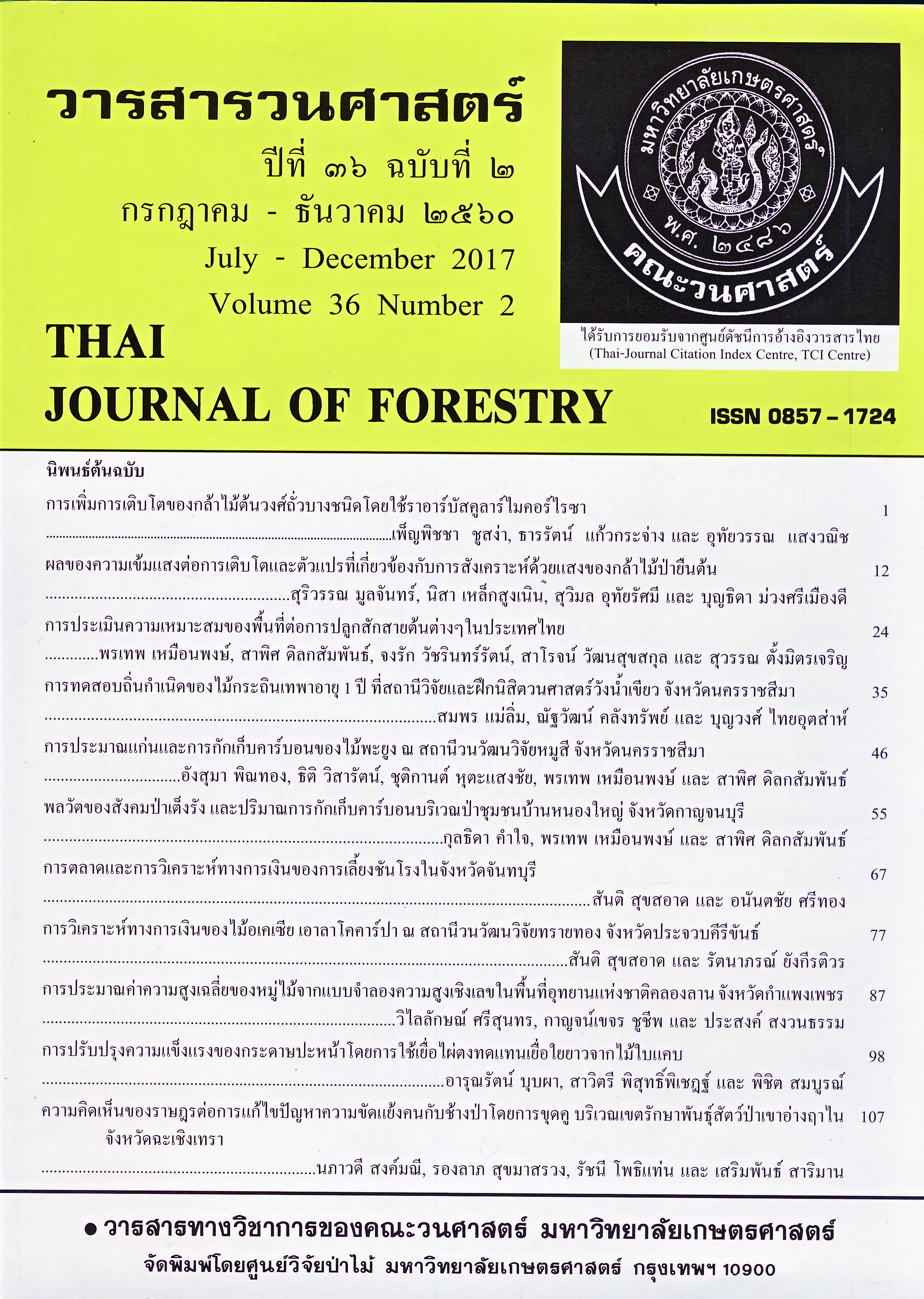การปรับปรุงความแข็งแรงของกระดาษปะหน้า โดยการใช้เยื่อไผ่ตงทดแทนเยื่อใยยาวจากไม้ใบแคบ
Main Article Content
บทคัดย่อ
โดยทั่วไปกระดาษปะหน้า จะประกอบไปด้วยกระดาษสองชั้น ได้แก่ กระดาษชั้นบนและกระดาษชั้นฐาน ซึ่งการผลิตกระดาษชั้นบนในโรงงานกระดาษ จะมีการใช้เยื่อไม่ฟอกสีเส้นใยสั้นจากไม้ยูคาลิปตัสปริมาณร้อยละ 55 และเส้นใยยาวจากไม้ใบแคบปริมาณร้อยละ 45 ในการศึกษานี้ จึงได้ทำการทดแทนเส้นใยยาวจากไม้ใบแคบที่ต้องนำเข้าจากต่างประเทศ ด้วยเยื่อเส้นใยยาวไม่ฟอกสีจากไผ่ตง ที่สัดส่วนการทดแทนเยื่อไม้ใบแคบต่อเยื่อไผ่ตงในระดับต่างๆ คือ 45:0, 30:15, 15:30 และ 0:45 ตามลำดับ
จากผลการศึกษา พบว่า เส้นใยไผ่ตงมีความยาวของเส้นใย (2.48 มม.) สูงกว่าเส้นใยของไม้ใบแคบเล็กน้อย (2.39 มม.) แต่กลับมีปริมาณผนังเซลล์ต่อพื้นที่หน้าตัดของเส้นใย ซึ่งแสดงด้วยค่าสัดส่วนรังเคิล (0.97) มีปริมาณที่มากกว่าในไม้ใบแคบมาก (0.64) ด้วยเหตุนี้ จึงทำให้กระดาษที่ผลิตจากเยื่อไผ่ตงมีสมบัติด้านความแข็งแรงต่อแรงฉีกสูงกว่า แต่ให้ความแข็งแรงต่อแรงดึงต่ำกว่ากระดาษที่ทำจากเยื่อไม้ใบแคบ เมื่อทำการผสมเยื่อไผ่ตงทดแทนลงไปในเยื่อไม้ใบแคบ พบว่า ที่สัดส่วนไม้ใบแคบต่อเยื่อไผ่ตงที่ 30:15 และ 15:30 ที่ทุกๆ ระดับการตีเยื่อ จะให้กระดาษที่มีค่าดัชนีความแข็งแรงต่อแรงดึง แรงฉีก แรงดันทะลุ และแรงกดวงแหวน รวมถึงความต้านทานต่อการหักพับ ที่สูงกว่ากระดาษที่ไม่มีการผสมเยื่อไผ่ตง ได้แก่ ที่สัดส่วนไม้ใบแคบต่อเยื่อไผ่ตงที่ 45:0 จะเห็นได้ว่า เยื่อไผ่ตงมีส่วนช่วยทำให้ความแข็งแรงของกระดาษดีขึ้น โดยอาจผสมเยื่อไผ่ตงทดแทนเยื่อไม้ใบแคบลงไปในกระดาษปะหน้าชั้นบน ได้มากถึงร้อยละ 60 หรือที่สัดส่วนการทดแทนที่ระดับ 30:15
Downloads
Article Details
ข้าพเจ้าและผู้เขียนร่วม (ถ้ามี) ขอรับรองว่า ต้นฉบับที่เสนอมานี้ยังไม่เคยได้รับการตีพิมพ์และไม่ได้อยู่ในระหว่างกระบวนการพิจารณาตีพิมพ์ลงในวารสารหรือสิ่งตีพิมพ์อื่นใด ข้าพเจ้าและผู้เขียนร่วม (ถ้ามี) ยอมรับหลักเกณฑ์และเงื่อนไขการพิจารณาต้นฉบับ ทั้งยินยอมให้กองบรรณาธิการมีสิทธิ์พิจารณาและตรวจแก้ต้นฉบับได้ตามที่เห็นสมควร พร้อมนี้ขอมอบลิขสิทธิ์ผลงานที่ได้รับการตีพิมพ์ให้แก่วารสารวนศาสตร์ คณะวนศาสตร์ มหาวิทยาลัยเกษตรศาสตร์ กรณีมีการฟ้องร้องเรื่องการละเมิดลิขสิทธิ์เกี่ยวกับภาพ กราฟ ข้อความส่วนใดส่วนหนึ่ง หรือ ข้อคิดเห็นที่ปรากฏในผลงาน ให้เป็นความรับผิดชอบของข้าพเจ้าและผู้เขียนร่วม (ถ้ามี) แต่เพียงฝ่ายเดียว และหากข้าพเจ้าและผู้เขียนร่วม (ถ้ามี) ประสงค์ถอนบทความในระหว่างกระบวนการพิจารณาของทางวารสาร ข้าพเจ้าและผู้เขียนร่วม (ถ้ามี) ยินดีรับผิดชอบค่าใช้จ่ายทั้งหมดที่เกิดขึ้นในกระบวนการพิจารณาบทความนั้น”
เอกสารอ้างอิง
สมหวัง ขันตยานุวงศ์. 2551. เอกสารประกอบการสอนเรื่องเส้นใยเยื่อและกระดาษ: สมบัติทางกายภาพ. ภาควิชาวนผลิตภัณฑ์ คณะวนศาสตร์, มหาวิทยาลัยเกษตรศาสตร์.
Bawagan, P.V. 1972. The Analyses of some Fundamental Fiber-Paper Property Relationship. M.S. Thesis, Norwegian University of Science and Technology.
International Organization for Standardization. 2011. Paper, board and pulp. ISO Standards Correction (CD-ROM), Geneva, Switzerland.
Kamthai, S. and P. Puthson. 2005a. The Physical Properties, Fiber Morphology and Chemical Composition of Sweet Bamboo (Dendrocalamus asper Backer). Kasetsart journal (Nat.sci) 39 (4): 581-587.
Kamthai, S. 2005b. Effect of Beating Revolution on Sweet Bamboo (Dendrocalamus asper Backer) Kraft Pulp. Chiang Mai journal sci 4 (2): 137-147.
Kline, J.E. 1991. Paper and Paperboard Manufacturing and Converting Fundamentals. 2nded. Miller Freeman Publications, inc., San Francisco.
Nitisoravut, N. and R.O. Malinen. 2007. Fiber morphology and papermaking properties of selected Thai bamboos. Appita Annual Conference 1: 83-89.
Panthai, S. and P. Somboon. 2014. Examination of Separate and Mixed Refining Method on Softwood and Hardwood Pulp for Linerboard Production. Kasetsart journal 48 (4): 540-547.
Pisuttipiched, S. 2004. Effect of Tree Age on Wood Properties of Eucalyptus camaldulensis in Thailand. Thai Journal of Forestry. 23 (2): 152-160.
Spencer, H.S., N.G.M. Tuck and R.W. Gordon. 1983. Beating and Refining, pp.136. In R.G. Macdonald and J.N. Franklin., eds. Pulp and Paper Manufacture. Mcgraw-hill book company, Atlanta.
Technical Association of the Pulp and Paper industry (TAPPI). 2002. 2002-2003 TAPPI Test Methods. TAPPI Press, Atlanta, Georgna.


